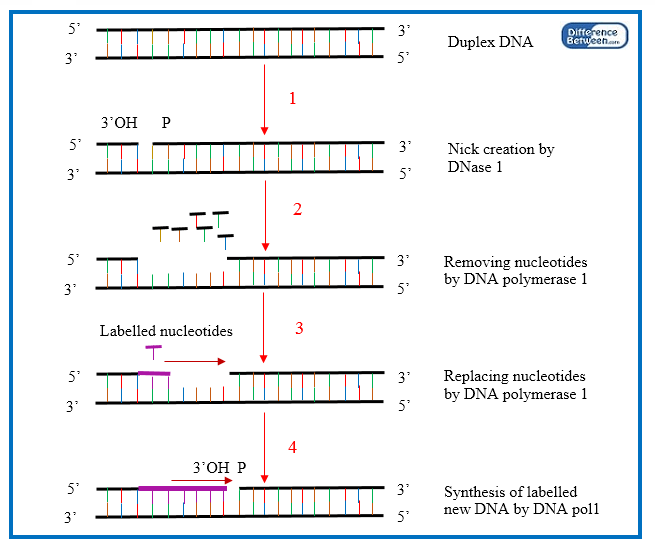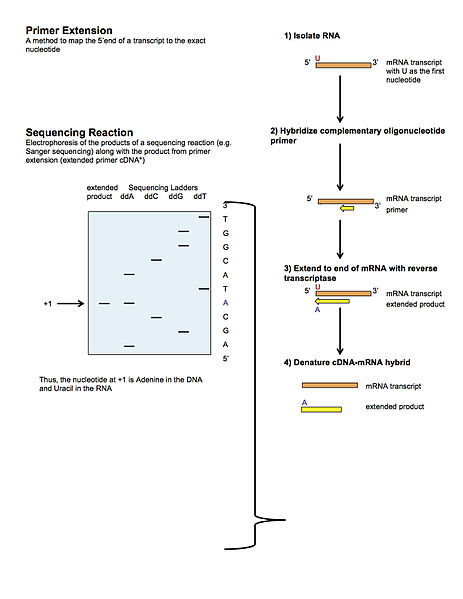Key Difference – Nick Translation vs Primer Extension
Nick translation and primer extension are two important techniques performed in Molecular biology. The key difference between nick translation and primer extension is that nick translation process produces labelled probes for other hybridization techniques while primer extension method identifies a specific RNA sequence from a mixture and reveals information about the expression of mRNA. Both techniques have great importance and are routinely performed in molecular research labs.
CONTENTS
1. Overview and Key Difference
2. What is Nick Translation
3. What is Primer Extension
4. Side by Side Comparison – Nick Translation vs Primer Extension
5. Summary
What is Nick Translation?
Nick translation is an important technique used to prepare labelled probes for various molecular biological techniques such as blotting, in situ hybridization, fluorescent in situ hybridization etc. It is an in vitro method of DNA labelling. DNA probes are used to identify specific DNA or RNA sequences. With the help of a labelled probe, specific fragments can be marked or visualized from a complex mixture of nucleic acid. Therefore, labelled probes are prepared using various techniques to be used for different techniques. Nick translation is one such method which produces labelled probes with the help of DNase 1 and DNA polymerase 1 enzymes.
The nick translation process starts with DNase 1 enzyme activity. DNase 1 introduces nicks in the phosphate backbone of double stranded DNA by cleaving phosphodiester bonds between nucleotides. Once the nick is created free 3’ OH group of the nucleotide will be yielded and DNA polymerase 1 enzyme will act on it. 5’ to 3’ exonuclease activity of DNA polymerase 1 removes nucleotides from the nick towards the 3’ direction of the DNA strand. Simultaneously, polymerase activity of DNA polymerase 1 enzyme works and adds nucleotides to replace the removed nucleotides. If the nucleotides were labelled, the replacement will occur by the labelled nucleotides and it will mark the DNA for identification. This newly synthesized labelled DNA can be used as probes in various hybridization reactions in Molecular Biology.

Figure 01: Nick translation process
What is Primer Extension?
Primer extension is a technique which is used to find specific RNA sequence from a RNA mixture and locate the 5’ end of the mRNA transcript. It is also used to study the structure of RNA and expression. Primer extension method is carried out with labelled primers or with labelled nucleotides. If labelled primers are used, it excludes the need of labelling the nucleotides which are used for the synthesis of cDNA. There are several steps in this technique. It starts with extraction of RNA from the sample. Then a labelled oligonucleotide primer is added to the mixture together with the necessary ingredients to synthesize cDNA of a specific RNA sequence. Primer anneals with the complementary sequence from the mixture. Using the primer annealed sequence as the template, the enzyme reverse transcriptase synthesizes the complementary DNA (cDNA) of the RNA sequence. Primer annealing and reverse transcription occur only when the specific RNA sequence is present in the sample. Finally, when denaturing gel electrophoresis is performed, the size of the RNA sequence can be determined. It is also easy to find the +1 base of the mRNA (transcription initiation site) sequence by the primer extension method. The amount of mRNA present in the sample is can be quantified by this method if excess primer is used.

Figure 02: Primer extension
What is the difference between Nick Translation and Primer Extension?
Nick Translation vs Primer Extension | |
| Nick translation is a process which creates labelled DNA probes for various hybridization reactions. | Primer extension is a technique used to find specific RNA or to study gene expression. |
| Enzymes Used | |
| DNase 1 and DNA polymerase enzymes are used. | Reverse transcriptase enzyme is used. |
| Importance | |
| Nick translation facilitates the marking of specific DNA sequence. | Primer extension enables detection of specific mRNA sequence size and the amount present in the sample. |
Summary – Nick Translation vs Primer Extension
Nick translation is a method used to synthesize labelled probes based on the activities of DNase 1 and E coli DNA polymerase 1 enzymes. It is an in vitro method employed in the laboratories prior to different hybridization techniques. During the nick translation, 5’-3’ exonuclease activity of DNA polymerase 1 removes nucleotides ahead of the nick and polymerase activity of DNA polymerase 1 replaces the removed nucleotides with labelled nucleotides behind the nick. Primer extension is a method which is used to detect a specific RNA transcript from a mixture and quantify the size and the amount of the interest RNA. This is the difference between nick translation and primer extension.
References
1. Reid, Alex. “Nick Translation.” Springer. N.p., n.d. Web. 18 Apr. 2017
2. “Primer Extension.” National Diagnostics. N.p., n.d. Web. 19 Apr. 2017
3. Kuo, M. T., and W. Plunkett. “Nick-translation of metaphase chromosomes: in vitro labeling of nuclease-hypersensitive regions in chromosomes.” Proceedings of the National Academy of Sciences of the United States of America. U.S. National Library of Medicine, Feb. 1985. Web. 19 Apr. 2017
4. Raymond et al. “Simple, quantitative primer-extension PCR assay for direct monitoring of microRNAs and short-interfering RNAs.” RNA. Copyright 2005 by RNA Society, Nov. 2005. Web. 19 Apr. 2017
Image Courtesy:
1. “Primer Extension Assay” By Jjnmmnjj – Own work (CC BY-SA 3.0) via Commons Wikimedia
ncG1vNJzZmivp6x7pbXFn5yrnZ6YsqOx07CcnqZemLyue8OinZ%2Bdopq7pLGMm5ytr5Wau266yJyiZqyilru0uMCtoKimXZa7pXnVrGSpqpmisrN5xLGrnqajnryvew%3D%3D